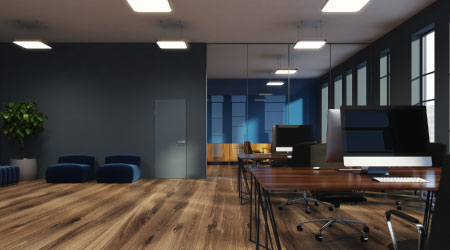Four Questions Narrow The Options For Resilient Flooring
By Lacey Muszynski, Assistant Editor
OTHER PARTS OF THIS ARTICLEPt. 1: This Page
Every organization, and every facility within every organization, have different requirements for flooring. All will expect the flooring to meet the needs of the occupants, but there are also expectations about how the flooring can affect the space.
“Commercial space is about human productivity,” says Jeff Krejsa, director of marketing, Johnsonite. “A motivating space, be it a hospital, school, corporate office, retail establishment or hotel, will contribute to greater productivity and greater return on investment for the organization.”
Realizing the greatest ROI and benefits from a hard surface or resilient floorcovering takes some research. With many factors to consider, some are bound to conflict, and that can leave facility executives with a big headache.
To avoid that pain, facility executives should weigh the options and examine the facility as much as the floorcoverings. Prioritizing the organization’s needs and wants will make the selection process easier.
“Performance, design, cost, environmental consideration — what is important to you?” says Dominic Rice, vice president of product management — commercial resilient for Armstrong. “Think about each part of your building and how it’s used, and then match the product to your budget, your maintenance requirements and the aesthetic you want to achieve.”
Here are four questions that facility executives should consider to get a better understanding of which resilient or hard surface flooring will work best.
1. How Will the Space be Used?
The obvious starting point for selecting flooring is determining what will be happening in the space. The needs of the occupants will dictate what the flooring should deliver: a combination of comfort, safety, durability and aesthetics. But it’s up to the facility executive to prioritize those factors and come up with the best flooring solution possible.
Talk to occupants of the space and examine the work they will be performing. If it’s a renovation project, ask occupants what is and isn’t working about the flooring. Facility executives will often get frank answers that will steer them in the right direction.
In other cases, the type of flooring needed will be clear. In some areas of health care, such as patient rooms and operating rooms, hygiene is of the utmost importance. It is uncommon to find anything other than sheet vinyl, especially in operating rooms, because seams in the floorcovering can be heat welded for an impervious, aseptic floor.
Other types of flooring are particularly suited to certain areas. Vinyl composition tile (VCT) is durable, long-lasting, and relatively inexpensive, and is often used in K-12 classrooms and schools. Sheet vinyl and linoleum are often used in hallways where a lot of heavy carts or equipment are rolled through because a sheet product has more “give” to wheels rolling over it. Rubber’s non-slip surface is a benefit in locker rooms, around pools, and in stairwells and kitchens. Cork, like rubber, is soft underfoot and is used where a similar aesthetic to wood is desired.
Both luxury vinyl tile and high-pressure laminate flooring are used in spaces where a natural product aesthetic is a priority, but durability is also an issue. Both feature a thin printed film just under the wear layer that gives the look of natural products with the durability of vinyl or laminate.
In spaces where comfort is a priority because occupants are on their feet a lot, such as nurse stations, the right flooring can contribute to employee productivity. Employees who are on their feet for long periods of time will be less fatigued and may even use less sick days on flooring that gives a little, like rubber or cork.
2. Is Sustainability Important?
In a growing number of cases, the answer to this question is “yes.” But how do facility executives determine how sustainable a floorcovering is?
A common myth is that sustainability in a resilient floorcovering can only be measured by the amount of recycled content and material make-up of the product, says Krejsa. But a number of factors can make a floorcovering sustainable.
Generally, resilient and hard surface floorcoverings have a long expected lifetime. With the proper maintenance, floors like VCT can last 30 years or more. The longer a floor is in service, the fewer resources that are consumed and the less waste goes to a landfill. What’s more, the production and transportation of new flooring materials produces emissions that can be avoided as long as the existing floorcovering remains in use.
To avoid flooring replacement before its useful life is up, it’s important to consider the design of the floorcovering. Aesthetically, flooring plays a large role in the overall interior design. It can contribute to the ambiance or mood of a space, whether that’s elegant, serene or lively — or it can look outdated. Facility executives should look at the work being performed in the space and choose an appropriate floorcovering, pattern and color. Avoid trendy colors and patterns and opt for more classic designs that will withstand the test of time so the flooring doesn’t need to be replaced for aesthetic reasons before its useful life is over.
Also be sure to compare manufacturers in terms of warranties, company longevity and customer support. If a floor needs a small area replaced 15 years down the road, is it possible it’s covered under warranty? Does the company still manufacture the same product?
“Be aware of warranties, the sales and technical service and support, and product availability — current and in the future,” says Rice.
Some floorcoverings require relatively little maintenance, including some sheet products, high-pressure laminate and rubber. The comparatively easy maintenance of some floors means that less water is wasted, fewer chemicals enter the waste stream from cleaning, and there will generally be better indoor air quality, says Krejsa.
Finally, many floorcoverings are made from natural materials or incorporate recycled materials. Linoleum is made from natural and renewable materials, as are cork and bamboo. Rubber is often recyclable at the end of its life and many rubber products contain recycled content, sometimes even from tires. Low-VOC floorcoverings that don’t offgas are available that can contribute to the indoor air quality of the space.
3. How Much Maintenance Should We Expect To Perform?
Depending on the aesthetic standard expected by the organization and the type of flooring, a certain amount of maintenance will have to be performed throughout the life of the floorcovering. Facility executives should understand the expectations on the upkeep and general condition of the floor. If the organization expects a high-gloss finish in the lobby at all times, VCT may not be a good choice because it would need constant buffing and waxing in such a high-traffic area, for example. Some flooring requires more regular maintenance than others, but all require some. “The life of the flooring is always extended by doing regular maintenance,” says Melissa Quick, marketing coordinator, Flexco.
If an organization wants a floor that will require lots of maintenance, the facility executive should look at whether the facilities staff can perform the extra work or whether it’s possible to outsource the work. This is always a balancing act of time, budget and resources. If the amount of maintenance for a particular floorcovering can’t realistically be performed, facility executives might have to research alternatives that fulfill both the organization’s goals as well as staff or budget restrictions.
It’s also important to consider that the maintenance schedule recommended by the manufacturer may not be appropriate for a particular facility. Every facility has different amounts and patterns of traffic and unique circumstances that will affect maintenance.
“By understanding the anticipated traffic and abuse levels of the space and the true potential maintenance of a floorcovering, not just the advertised maintenance, you’ll get an accurate portrayal of the cost of maintenance over the life of the space,” says Krejsa.
To find out if maintenance expectations are realistic once the field has been narrowed down to a few choices, facility executives can ask manufacturers for locations where the product has been installed.
“They should ask about previous installations to get testimonials from individuals who have used the product,” says Quick. “You can see if it’s the best product for your particular application.”
4. What Can We Afford?
Facility executives who only consider first costs in their financial evaluations are not looking at the whole picture and may be missing out on substantial savings down the road.
“Selecting flooring is an investment and a business decision and should be taken within the same context as other financial and ROI considerations,” says Krejsa. “Ultimately, a lifetime return should be measured.”
To calculate the cost of flooring over its entire life, facility executives should crunch some numbers. Calculate the cost of the product, installation costs, estimated maintenance costs, possible unscheduled repairs, and reclamation or disposal costs at the end of the floor’s life. Add these estimates together, then divide by the estimated number of years the flooring will last to get a cost per year. If facility executives do this for each flooring contender, it’s easy to compare apples to apples in terms of budget.
Some floorcoverings give facility executives the opportunity to save money at different stages of the product’s life. High-pressure laminate, for example, can be installed over most existing floors, saving money on removal costs of the old floor, says Tammy Weadock, marketing manager, Wilsonart. Some floorcovering can be recycled at the end of its life, saving on landfill costs. Several manufacturers even collect their products at no cost, reusing the materials in the manufacture of new product.
While first cost often has the most weight when it comes to selecting a resilient or hard surface floorcovering, it shouldn’t be to the detriment of the flooring’s performance.
“Most facilities tend to run tight on budget by the time the flooring goes down, so there is compromise on quality for price sometimes,” says Quick. “But the flooring takes more abuse than most anything in the building and there should be more emphasis placed on the flooring than sometimes actually goes into it.” 
Related Topics:












